#he’s baby to me and also he has an american eagle campaign which i’m not really sure is relevant but i just thought about it so
Note
Why’d lukey have to make it look so onlyfans-like? Lol
absolutely LOSING IT trying to figure out what this meant until i remembered the spoons video and now i need to know what is so “onlyfans-like” 🤲🤲 bestie drop the elaboration,,, i see intricate rituals? “come on, it’s the finals bro”? the circle of boys around them AND very-clear-yet-still-apparently-dumbfounding pranking?? the whole thing seems so sweet & silly but i am willing to be swayed 😗
#liv in the replies#compiling all the usntdp team usa asks for future me#was trying to remember the tag i used for cole & got ‘damn really ok what do you want me to do about it bark?’ & that’s 😭😭😭 nope#‘i don’t know what you want me to do with that like am i supposed to bark’#lmao sorry to not have content u want but apparently if ur name is a variation of luke/cas u’ve been relegated to the status of my pet rock#he seems such just like. everyone’s little kid brother that i simply do not see it but i am willing to be convinced? take a shot#he’s baby to me and also he has an american eagle campaign which i’m not really sure is relevant but i just thought about it so#me a known freak slapping the side of that video like good natured jolly old pg fun here folks! i do Not See It#to be clear this is also said very nicely!!! i used to (still) view brady tkachuk like a communal shower but look at me now being unhinged#come into the inbox pls /srs & i will happily reassess (also i don’t think i know what here is supposed to be of-like 😭 camera angle? him??)
3 notes
·
View notes
Text
The Soul of the Nation
I know I keep saying that I have finally reached the bottom, that there simply is nothing left in the universe’s bag of tricks that could or will surprise me. But it consistently turns out that I was wrong and this morning, as I opened some of my usual news sites to see what was being featured as the morning’s news, I found myself so flabbergasted—and so outraged—that, yet again, I have to eat some crow: I thought nothing could surprise me any longer, but I was clearly wrong. Again.
I am referring to the news report published this morning revealing that the team of lawyers appointed by a federal judge to identify the specific would-be migrant families whose children were taken from them at the border, that this team of especially appointed legal eagles have admitted that they have failed, not once but in 545 different cases, to track down the parents of the children involved. And also, just to make the lot of these poor children even more dismal, the likelihood is that about two-thirds of their parents were deported to Central America without any mechanism having been set first in place to keep track of their whereabouts so that they could be reunited with the children taken from them once they were sent home.
This is America? It hardly seemed possible to me then that children were being separated violently from their parents in the first place. But infinitely less possible for me to fathom is that we have somehow failed to create a foolproof mechanism for reuniting this families torn asunder by agents of our own government.
I am not a believer in open borders. I understand the need for would-be immigrants to follow the rules and apply for admission in a dignified, decorous way that conforms to American law. My own wife is an immigrant to this country and she carefully played by those very rules when she came here in 1999. But if the parents involved were attempting to circumvent the law and illegally sneak into our country, what crime did their babies commit? Or children so young then that they are incapable of saying clearly now where their parents were originally from, thus where they would likely have been deported back to. My guess is that some of the children who were taken as babies are probably not even able to say what their parents’ full names are, let alone their original addresses.
This will be addressed in future weeks, I suppose. The current administration is under court orders dating back to 2018 to reunite families separated at the border. Is it even remotely possible that there simply is no way to do that? Jewish readers even moderately familiar with their own history will certainly know the answer to that question. And it does not at all redound to the credit of our nation.
In my opinion, this issue, almost more than any other, goes to the question of our nation’s soul.
The notion that the national soul is in play in the current election is hardly original with me, of course, as witnessed by Joe Biden’s remark the other day that the campaign for the White House isn’t “just about winning votes,” that is it “about winning the heart and, yes, the soul of America.” For its part, the Trump campaign has lately been using the same language: the slogan “Save America’s Soul” surfaced just last week to encourage donors to contribute to the campaign. Reporter Elizabeth Dias wrote an interesting essay in the Times the other day about the use of this specific kind of language to suggest what’s really at stake on November 3, but she didn’t turn to the text I wish to present here with my interpretation as my own contribution to the discussion. (To read Dias’s article, click here.)
She did cite a lot of interesting sources, that I do have to give her. Referencing authors like Frederick Douglass (who felt that the struggle against slavery had to lead to the abhorrence of slavery being “fixed in the soul of the nation”), Lyndon B. Johnson (who spoke about the nation finding its “soul of honor” on the battlefield at Gettysburg), and Martin Luther King, Jr. (who described the mission of the organization now known as the Southern Christian Leadership Congress as one “to save the soul of America” by promoting civil rights and racial equality), she sets a good literary base upon which to stand while expatiating about the meaning of the concept under consideration and asking what it means—or could mean—for a nation to have a soul that animates and guides it along, presumably in some analogous fashion to the way the human soul animates and guides the body that houses it.
But she didn’t get to Whitman, the greatest of all American poets and—at least in my opinion—the author of the greatest of all American books, Leaves of Grass.
Whitman’s poem “By Blue Ontario’s Shore,” opens with a vignette that goes to the heart of the matter. The poet imagines himself wandering along on the U.S. side of Lake Ontario shortly after the end of the Civil War. (I’m citing the poem’s final version; the first was written before the war.) And there he is sauntering along when all of a sudden “a Phantom gigantic superb with stern visage” accosts him. “Chant me a poem,” the phantasm demands, one “that comes from the soul of America.” And then, in case the poet still didn’t quite understand the task being laid at his feet, the creatures restates the challenge: Sing me, it says, “the song of the throes of Democracy.”
That’s quite the challenge, defining the soul of a nation. But Whitman was up to it…and what he had then to say about the soul of the American nation is as relevant and inspiring today as it was when the poem reached its final state in 1867.
“By Blue Ontario’s Shore” is a long, complicated poem. But the single idea that comes through again and again is that, while other nations exist primarily as entities that subsume their own populations, the American concept is precisely the reverse: that the individual (and, by extension, the rights of the individual) are sacrosanct and the nation is merely the aggregate of the individuals who constitute its population. In other words, what makes America unique is the idea that the nation exists for the sake of its citizens, not vice versa, and that the identical set of basic human rights are thus at the core of both citizen and citizenry.
America, Whitman writes, is “Underneath, all individuals / I swear nothing is good to me now that ignores individuals, / The American compact is altogether with individuals, / The only government is that which makes minute of individuals, / The whole theory of the universe is directed unerringly to one single individual—namely, to You.” That, he is saying, is why the most basic American document is the Bill of Rights, which delineates the rights not of the nation or of the states, but of the individual. This corresponds precisely to what Whitman wrote in the Preface to Leaves of Grass: “The genius of the United States is not best or most in its executives or legislatures, nor in its ambassadors or authors or colleges or churches or parlors, nor even in its newspapers or inventors…but always in the most common people.”
And that idea, so Whitman, is the soul that animates the American ethos, the notion that the nation can hardly even be said reasonable to exist at all other than as an aggregate of its individual citizens.
In that concept of the supreme worth of the individual rests the mission that destiny has laid at the nation’s feet, making of it not a declaration to inform or a riddle to be solved, but a kind of physically-real poem intended by its author/founders to inspire others to resist the siren call of self-serving nationalism that sees the individual as a cog in a giant machine and instead to embrace the notion that nations exist solely to promote the worth of the individual citizen possessed of inalienable rights and limitless potential. To fit that thought into the question of the children I wrote about above, the fact that the government behaved with respect to those poor children in a way that not a single American would countenance in a million years with respect to his or her own children—that they be seized, warehoused, and lost track of as a way of punishing the wrongdoing of their parents—means by definition that the nation’s leaders have betrayed the people who entrusted them with the mantle of national leadership in the first place.
“These States are the amplest poem,” Whitman writes. “here is not merely a nation but a teeming Nation of nations, / Here are the doings of men correspond with the broadcast doing of the day and night, / Here is what moves in magnificent masses careless of particulars, / Here are the roughs, beards, friendliness, combativeness, the soul loves / Here the flowing trains, here the crowds, equality, diversity, the soul loves.” I love those words because they correspond to my own sense of what makes America unique. Like many, I fear we may have lost our way and need to find a path that will put us back on the track of our own national destiny, one that will lead us to embrace the Founders’ vision of a union of states that exist to create the legal and societal context in which individuals can flourish and reach the fullest flower of their potential. The nation is the individual. No act that the individual citizen would find abhorrent can reasonably be rationalized because it was undertaken by the government and specifically not by the individual. The nation is its citizens. The citizens are the nation. Their moral bearing must therefore be their nation’s as well. Policies supported by none cannot be pursued by the government without the nation sinking to the level of tyranny it was founded specifically to resist.
To me, that is what America is…and wherein lies the specific way it differs from other nations—and particularly from the nations from which its original founders and later immigrants hailed. That intense, unselfconscious celebration of the individual is how Whitman responded to the gigantic Phantom superb with stern visage who demanded of a definition of the American soul. I personally would be incapable of ripping a baby from its mother’s arms at all, let alone doing so without guaranteeing to myself in a dozen different ways that that family will end up reunited when its parents are either granted entry into our country or sent home. That obliges me to speak out when my government appears to have failed in the most elemental way possible to watch over the children in its care. I respond therefore to this week’s revelation not merely with regret, but with rage born of indignation and shame.
0 notes
Text
My Style Analysis: Mrs. America Beauty Parlor Scene
*Spoilers Ahead for Mrs. America*
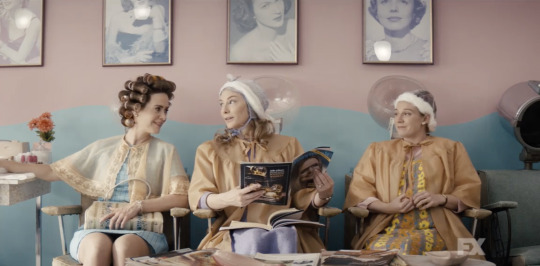
Picture this: 1971, a beauty parlor that is stuck in the year of it’s founding (1962) with no trace of the hairstyles that happened in the nine years since it started.


Those are promo pics for Seasons 3 and 7A of Mad Men which was set from 1960-1970. In fact they have a beauty parlor scene too set in 1962:

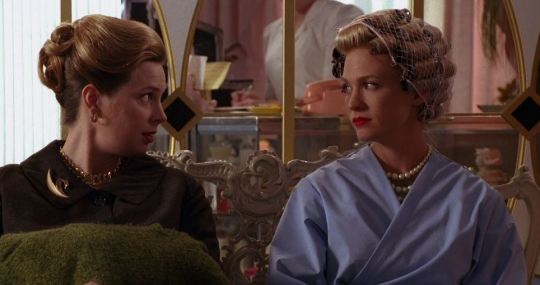
Color scheme is the same (pastel pinks and aqua tones) although it looks fresher and more cosmopolitan (check the gold and black touches in the 1962 scene with the atomic fixtures) than in the 1971 scene (plainer, with dated photos, and traditional attitudes about being a wife and keeping your body Cheryl Tiegs-slim even after giving birth to 6 kids and pushing 50) in contrast to this scene from The Battle of the Sexes:

More graphics with the women (both the players and the beauticians with modern hairstyles, even an afro).
Now that I have set up the interior design, lets go on to the women featured in the Mrs. America scene where I will contrast them with some Mad Men pics:

Betty Draper pastels and cardigan, check. A “gracious lady” expression with some hidden tools, check. Scarf done a la Peggy Olson, check. A more severe and conservative version of Joan Holloway Harris’s updo, check. Eyeshadow done like warpaint, check. She and Joan would never see eye to eye.

This is a woman rigid in her Daughters of the American Revolution background (check that Eagle brooch) and her Catholicism that she can’t see, or rather, refuses to see the need for an amendment that would protect women from different backgrounds from discrimination. Clearly also she is Betty Draper’s country cousin (Main Line Betty living in New York bedroom communities) or Peggy Olson’s wealthy and more assimilated distant relative (Peggy’s older relatives with Brooklyn accents in contrast to the patrician Midwestern accent of Phyllis).
She smiles away at the younger Pamela’s worries about easing her way into impending mother hood (notice her size), about maintaining a slim figure after having the many children that “God will bless her with”, Alice’s worries about being considered irrelevant as a upper-middle class housewife amongst her husband’s colleagues wives having their own careers and her fears of having to support herself financially and their confusion over how a woman as beautiful as Gloria Steinem would choose to not marry. Phyllis chooses to make such a woman sound deficient, failing to understand (despite being much worldlier than her less-educated counterparts who likely married out of high school) why a woman who can have her pick of male admirers would choose to not settle down. Joan can tell her a few things. Put a pin in that fugly jacket she’s wearing to protect her clothes from hairs.

Now on to Alice, Phyllis’s friend who worries about the Equal Rights Amendment and what it will mean for her. Alice has what is now called dyslexia and when she was growing up (1930s and 1940s), there were barely any resources to help dyslexics or diagnose the condition; actually most suffered from ridicule targeting their intelligence or work ethic. Lucky for Alice she came from a close-knit community and a family that did love her but hampered her independence (as we see in “Houston” she hardly has dealt with inconveniences like hotel room shortage in her life before that), that family also had wealthy parents (enough to live in those houses) and she was able to lean into the Prom Queen ideal and marry a guy she dated in high school at 19. But think about the experiences of a dyslexic person from a working-class background? One who doesn’t fit the standard of beauty that Alice does. Or one with a darker skin color? Or one for whom English is a second language, there are a lot of privileges that Alice is blessed with what do hamper her independence, confidence in herself, and her view of the world and what other women put up with.
Now on to Alice’s salon jacket. Alice sticks out for me because in contrast to Phyllis and the others, she wears button down patterned shirts with skirts that look more modern and casual; despite dipping into the neutral tones and pastels worn by her conservative and religious (and somewhat narrow-minded and ignorant to privilege) peers, Alice is seen in bright colors and autumnal tones. She also expresses compassion for marginalized groups (apologizing when she saw how her homophobia can hurt the lesbians serving food in their lounge and speaking up when one of her own peers makes racist comments), she is forced out of her gilded cage more to the point of view of others (like her abused friend Pamela), and she learns that Phyllis doesn’t empower her but rather feeds off of Alice’s fear of the upward trajectory of working women and how it’d affect her. Alice’s salon jacket, unlike the frumpier and cumbersome ones worn by Phyllis and Pamela, is very cropped like an extra accessory and lightweight and light-colored. Also note the light blue with brown plaid ensemble that Alice wears, it and the jacket are costume foreshadowing to Alice becoming a independent working girl.
Honestly if she talked to Willie (or not possible because maybe Willie wouldn’t feel that secure talking to her), she would see that someone like Willie isn’t threatened by women like Shirley Chisholm succeeding, actually as we saw in “Phyllis”, Willie looked like her heart was singing with joy.

Here is a story that DOES NOT make my heart sing with joy or schadenfreude: young Pamela Whalen.
She is the youngest and most impressionable of the STOP ERA housewives and this is a woman who CLEARLY needs feminism so bad. This girl from her first scene is straight up told the worst thing she can be after having babies and being married is to not fit into her wedding dress, her role models are old-school women who are in relationships that are toxic or at best unappreciative (Read Re-Making Love’s part about Fundie sex). Her husband is noted to be controlling of her comings and goings, even yanking her at a friend’s son’s wedding, he gets her pregnant constantly, “has a temper” she has to tiptoe around just for her sanity, and controls the house budget.
I’m gonna get right to her jacket because it helps me make sense of her tragic end: same as Phyllis the older woman who tells her that if she is obedient and makes her abusive husband “feel needed” (i.e. she probably pretends to not have an ounce of independence or capabilities that she built up for the then past 7 years) he will treat her decently. This is a girl who is stuck in a different, much more repressive time and with what looks to be a lack of formal work history or education and with her attitude staying in the kitchen, she’s being hurt by the cause she has campaigned for. She has a Betty Draper ending and the lifestyle: this is how young women (even some older than she were doing their hair).

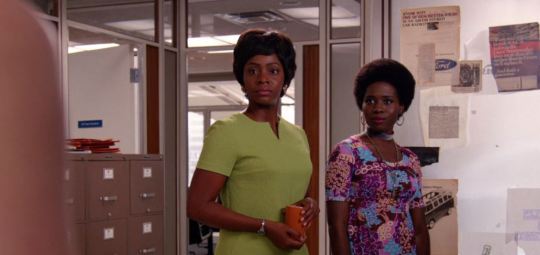

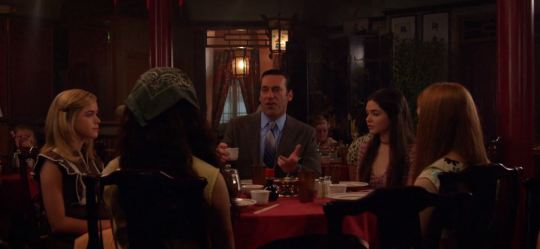
Check the young feminists in the show too and the tennis players in Battle of the Sexes (even the conservative and homophobic Margaret Court is more modern). The Mad Men women likely visited salons but they were going for modern, less time-intensive hairdos. As another example here are some mothers on Stranger Things (who are around Pamela’s age):


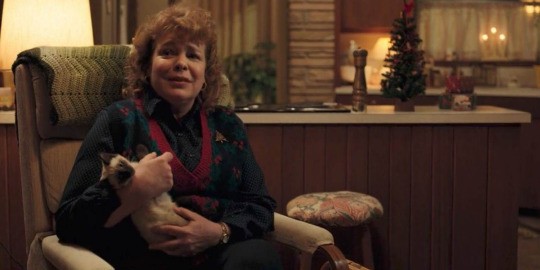


The nice thing is that when Mrs. America ends is that Pamela is still a young woman and therefore has a lifetime of risks and opportunities that can be there for the taking and hopefully she keeps her mom, sister-in-law, and Alice as her personal Girl Squad Versus Kevin.
#costume design#period costume#period piece#costume analysis#wardrobe analysis#fashion analysis#Mrs America#1970s Fashion#1970s Beauty#phyllis schlafly#alice macray#Pamela Whalen#Pamela Mrs America#Mad Men#The Battle of the Sexes#Stranger Things#White Privilege#Karens#the Karens#Karen
1 note
·
View note